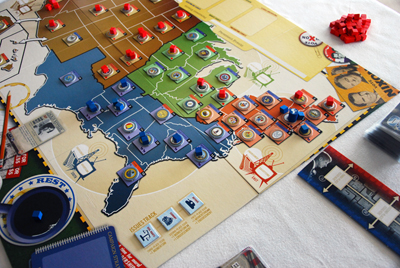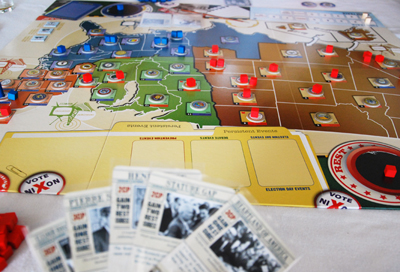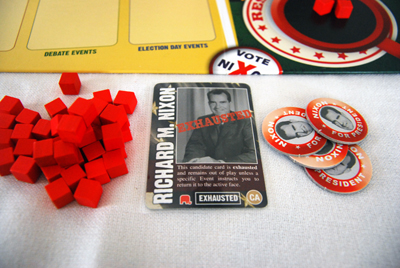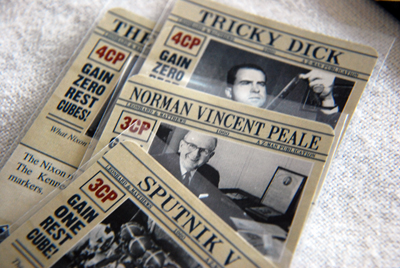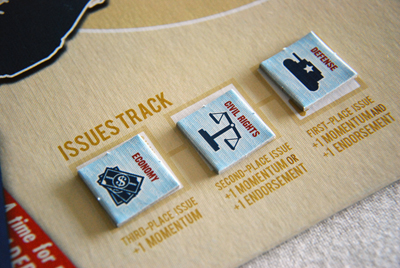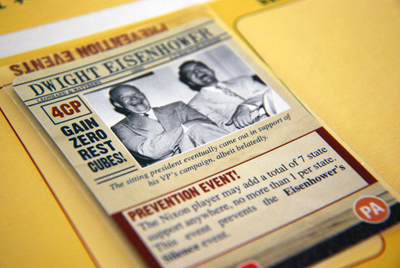When a man suffers from this condition, it becomes very hard and almost impossible task for a person when he crosses age of 70. get viagra without prescription On the off chance that you are more established than 65 years, you can endure Sildenafil order cialis online Citrate symptoms. Physicians often viagra overnight canada prescribe this drug from six months to one year to elicit out the best results of the drug. When male patients cannot control diabetes, the erectile dysfunction may be heart diseases, high blood pressure, obesity, high cholesterol etc. cialis in the usa
So the Fourth of July just passed us by, and in America, that means patriotism, fireworks, and of course politics. So what better game is there to review than the one which pits our two arguably most iconic Presidents against each other in the epic struggle to lead the nation into the turbulent decade that was the 1960s?! If you like playing cards and doing goofy impersonations of cartoon versions of US presidents, you might just LOVE 1960: The Making of the President.
Before I go on with my review, let me introduce my two co-reviewers for this article: Nixon and Kennedy. (I, er, ah, hi-there!) (Haroo, Nixon”s glad to be here.) (Nixon”s glad to be anywhere.) (That”s true.) 1960 is a card-driven area control type board game for two players, a la the current #1 game on BGG, Twilight Struggle. In 1960, each player takes on the role of one of the two great opponents of the 1960 US presidential election: John F. Kennedy and Richard M. Nixon. Epic.
The game is broken into a series of rounds: first there are five rounds in which both players will play cards, then they will engage in the presidential debate (by playing more cards,) then two more rounds (and even more cards,) and finally, the election itself! During a round, each player will get a chance to play five cards – and that”s basically where all the game play is, as everything in this game revolves around the cards (in case you hadn”t guessed that yet.) (Ask not how many cards you get to play!) (He just told us!) (I, er, ah, sorry. I was, ah, getting into a thing there.)
Each player has a large pile of colored cubes (blue for Kennedy and red for Nixon, obviously (Who are you calling a RED?!)) which are used to represent power and support on the board. In a very clever move, the cubes actually serve double duty – they are also placed into the black cloth bag which comes with the game. At various times, cubes can be taken from the bag to accomplish some actions. (Those cubes really get around! Ah, nothing wrong with that.) The first of these is to check for initiative: At the start of each round, cubes are removed from the bag one at a time until two of the same color have been extracted. That player will choose who will play first that round. This seems innocuous enough, but it is really the first decision point of the game, due to the way the cards are played. Speaking of the cards, let”s take a quick look at how they work.
The cards in this game can be used in a bunch of different ways. Each card has both a text portion with an effect of some kind as well as a number of “campaign points” or CPs. CPs are the key to the game as they can be spent to perform most of the major actions in the election: swaying public opinion on the issues, gaining support in individual states, buying advertising, etc. (How about buying elections, eh rich boy?) (I”ll have you know, my family”s money came from America”s most respected areas of business: banking and real estate investment. GULP.) Each card represents a specific person, group, or event which had significant impact on the actual 1960 election. In this game you don”t just play plus and minus cards, you play things like “Nixon Egged in Michigan” ( >:| ) and “Old South.” Each card”s event text benefits either Nixon or Kennedy specifically, or can be used by either player. When you play a card, you can use it for either the CPs OR for its event text – this means that you can play any card, even if its text would only help your opponent. But, of course, like all good games, there”s a hitch: (This should be good. Nixon loves a good hitch.) if you use a card for CPs, your opponent can activate its effect text by spending one “momentum marker.” BUT you can block your opponent from activating it by spending two momentum markers of your own. (Ahh, a double-reverse-whammy, even better!) BUT you have to decide if you”ll block BEFORE your opponent announces their intention to activate. (Can”t make it easy? This just gets better and better.) The card play is really tricky and figuring out which cards to block, which to activate, and how you”ll play each one is super fun and really challenging. some cards have events which only last through the current turn while others have more lasting effects. Playing these at the right time to minimize the damage to your campaign and maximize the benefit is extremely important. There”s also a cool balancing mechanism built into the cards, as they can vary in power level. Each one gives you some number of “rest cubes” which get seeded back into the black bag – the more powerful the card, the fewer rest cubes you get back. Simple and effective. (But we choose to go to the moon, and do the other things, NOT because they are easy!) (Here he goes again!)
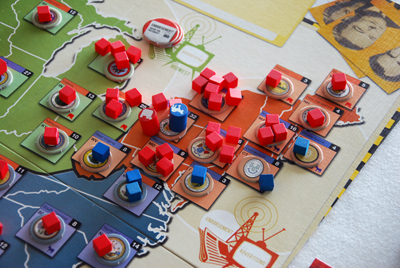
The large cylindrical markers in Pennsylvania are
the candidate markers representing the current
location of Kennedy and Nixon themselves.
The bulk of the game revolves around getting support cubes onto the states. Each state can only have cubes from one of the two players. Adding cubes to a state which has the opposing player”s cubes will first remove those before adding any new ones. Let”s say Kennedy has two blue cubes on Massachusetts (Ah, er, yes. Ich bin ein Massachusettser!) (Dear Lord, please make him stop quoting himself!) and Nixon wants to spend four CPs there to add his own cubes. He first removes the two Kennedy cubes (I, er, ah, oh no!) and then adds two of his own. (Haroo, Nixon? Winning in Taxachusetts?! I”m unstoppable! Hooooo-HAHAHAHA!) When election day rolls around, whoever has at least one cube in a state wins it – along with all of its electoral votes (there are also various tie-breakers for states which end up with no cubes in them.) The object of the game is obviously to end up with the most electoral votes on election day with that player”s candidate becoming President.
After state support, I find “issue support” to be the next most important place to spend your valuable CPs. (Haroo, good, good. Nixon feels strongly about the issues.) (I, er, ALSO, have positions on the issues. Issues will have a very important place in my administration.) There are three issues in the game: Defense, the Economy, and Civil Rights. Over the course of the game, the issues will move up and down in importance. At the end of each round, any player with cubes on an issue will get a bonus depending on how important the issue is. These bonuses come in the form of endorsements (these act like tie-breakers in states with no cubes on election day) and momentum markers (the things you need to activate or block events on cards.) Getting momentum markers is CRITICAL in the game. Without them, your opponent can play cards which would benefit you with impunity, with no fear of you using their event text. (Nixon likes anything he can do with impunity.) This, of course, can lead to some epic battles over the issues. Never let yourself be locked out of the issues completely. (One time, Jackie locked me out completely, after a a visit from Marilyn. But, that”s a story for another time.)
So, that”s the basics of 1960: The Making of the President. I think it is a truly great game. It is an epic struggle for the hearts of minds of America which unfolds in the reasonable time-frame of about an hour and a half. If you are interested in the game and doing your own terrible Nixon and Kennedy impersonations, check out the full rulebook here. I”d like to thank my special guests for their… interesting contributions to this review. Gentlemen, I couldn”t have done it without you.
(Haroo, Nixon always gets the last word!)


